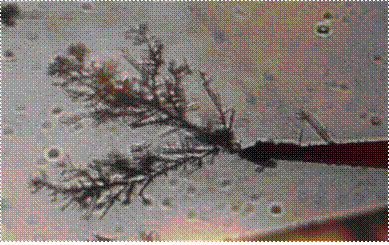Coupling a Bessel Beam and Damaging Nanowires
by Daniel M. Todd
Supervisor: Dr. Carlos Trallero
Kansas State University Physics Department REU Program


Home Research Results About Me
Results
Axicon Project Results:
For our final set of data, we
took power measurements before and after the fiber. We analyzed data from six different fibers,
each with a differing inner diameter size as well as from the same setup using
only the focusing lens and no axicon. These
measurements were taken with our 15mW HeNe at an
initial power of 3.72mW:
|
Inner Diameter (μm) |
Transmitted Power (mW) |
Efficiency (%) |
|
250* |
2.08 |
55.9 |
|
300 |
0.36 |
9.7 |
|
350 |
0.78 |
21.0 |
|
400 |
0.77 |
20.7 |
|
450 |
0.48 |
12.9 |
|
500 |
0.40 |
10.8 |
|
Lens** |
2.32 |
57.6 |
*This 250μm fiber was different than all of the others. It was a different brand and was shorter than all of the other fibers at 39.5in compared to 48in for the others.
**This measurement was taken with the 500mm focusing lens into the fiber (no axicon present). The initial power measured for this trial was 4.03mW since the axicon was not present to reduce the power down to 3.72 mW.
From this final set of data,
we can see that our best efficiency comes from the 250μm fiber at
55.9%. Unfortunately, this result is not
greater than our base efficiency provided by the lens trial at 57.6%. This may seem discouraging, but given more
time, better alignment, etc, it is possible that we
could eventually produce an efficiency significantly greater than our base
efficiency. It should also be noted that
the fibers with inner diameters of 300μm or greater were not fully tested
before placing them in this experiment.
In the near future, they will tested extensively to see if they were
poorly manufactured or otherwise not ideal since the values given in the data
stand in stark contrast to the 250μm fiber.
Nanowire Project
Results:
Overall, we were not
able to make much progress with this project.
I succeeded in creating a slide design that held 20 electrodes in which
we could grow the nanowires and was able to make about a dozen of them since it
was a very time-consuming process. We
attempted to grow nanowires but since Adam Summers and I did not have much
experience growing them, we were not able to produce many high-quality gold
nanowire samples. Here are a few images:
The two images on the left are ideal samples that we were hoping to grow more
of while the image on the right is an example of what we were able to produce.


Since we were not able
to produce many high-quality gold nanowires, we were not able to begin the
experiment which studied the effect of light polarization on the intensities
necessary to damage these nanowires.